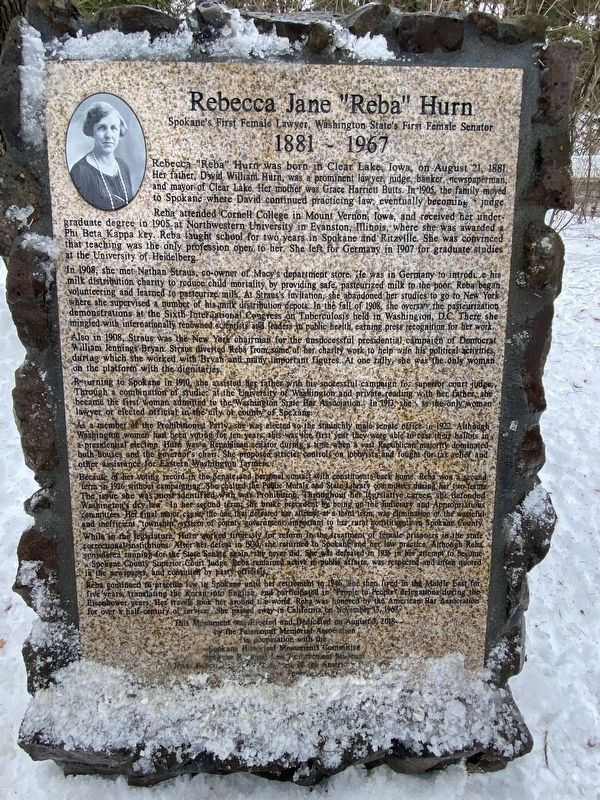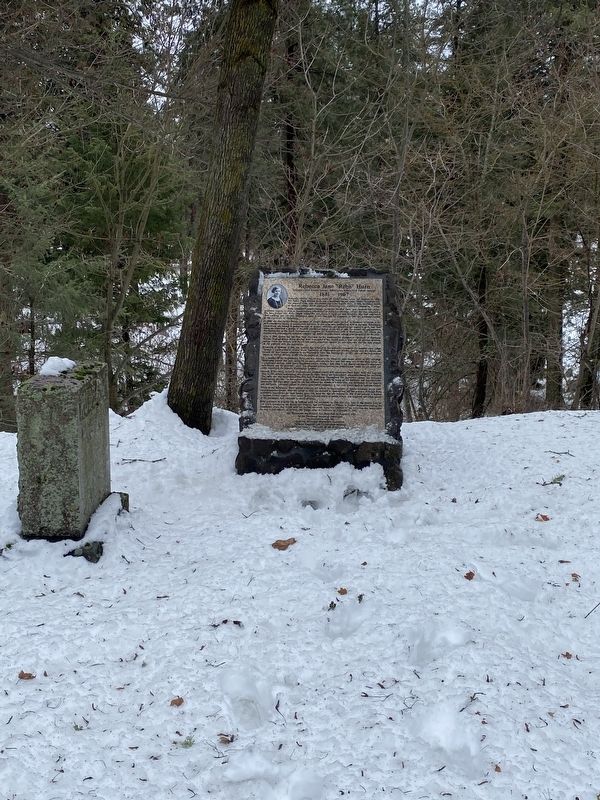Spokane in Spokane County, Washington — The American West (Northwest)
Rebecca Jane “Reba” Hurn
Spokane’s First Female Lawyer and Washington State’s First Female Senator
— 1881 - 1967 —
Rebecca "Reba" Hurn was born in Clear Lake, Iowa, on August 21, 1881. Her father, David William Hurn, was a prominent lawyer, judge, banker, newspaperman, and mayor of Clear Lake. Her mother was Grace Harriett Butts. In 1905, the family moved to Spokane where David continued practicing law, eventually becoming a judge.
Reba attended Cornell College in Mount Vernon, Iowa, and received her undergraduate degree in 1905 at Northwestern University in Evanston, Illinois, where she was awarded a Phi Beta Kappa key. Reba taught school for two years in Spokane and Ritzville. She was convinced that teaching was the only profession open to her. She left for Germany in 1907 for graduate studies at the University of Heidelberg.
In 1908, she met Nathan Straus, co-owner of Macy's department store. He was in Germany to introduce his milk distribution charity to reduce child mortality by providing safe, pasteurized milk to the poor. Reba began volunteering and learned to pasteurize milk. At Straus's invitation, she abandoned her studies to go to New York where she supervised a number of his milk distribution depots. In the fall of 1908, she oversaw the pasteurization demonstrations at the Sixth International Congress on Tuberculosis held in Washington, D.C. There she mingled with internationally renowned scientists and leaders in public health, earning press recognition for her work.
Also in 1908, Straus was the New York chairman for the unsuccessful presidential campaign of Democrat William Jennings Bryan. Straus diverted Reba from some of her charity work to help him with his political activities, during which she worked with Bryan and many important figures. At one rally, she was the only woman on the platform with the dignitaries.
Returning to Spokane in 1910, she assisted her father with his successful campaign for superior court judge. Through a combination of studies at the University of Washington and private reading with her father, she became the first woman admitted to the Washington State Bar Association. In 1913, she was the only woman lawyer or elected official in the city or county of Spokane.
As a member of the Prohibitionist Party, she was elected to the staunchly male senate office in 1922. Although Washington women had been voting for ten years, this was the first year they were able to cast their ballots in a presidential election. Hurn was a Republican senator during a time when a vast Republican majority dominated both houses and the governor's chair. She proposed stricter controls on lobbyists and fought for tax relief and other assistance for other Eastern Washington farmers.
Because of her voting record in the Senate and personal contact with constituents back home, Reba won a second term in 1926 without campaigning. She chaired the Public Morals and State Library committees during her two terms. The issue she was most identified with was Prohibition. Throughout her legislative career, she defended Washington's dry law. In her second term, she broke precedent by being on the Judiciary and Appropriations committees. Her final major cause, the one that defeated her attempt at a third term, was elimination of the wasteful and inefficient "township" system of county government, important to her rural constituents in Spokane County.
While in the legislature, Hurn worked tirelessly for reform in the treatment of female prisoners in the state correctional institutions. After her defeat in 1930, she returned to Spokane and her law practice. Although Reba considered running for the State Senate again, she never did. She was defeated in 1936 in her attempt to become a Spokane County Superior Court Judge. Reba remained active in public affairs, was respected and often quoted in the newspaper, and consulted by party officials.
Reba continued to practice law in Spokane until her retirement in 1946. She then lived in the Middle East for five years, translating the Koran into English, and participated in "People to People" delegations during the Eisenhower years. Her travels took her around the world. Reba was honored by the American Bar Association for over half a century of service. She passed away in California on November 13, 1967.
Erected 2018 by Fairmont Memorial Association in cooperation with the Spokane Historical Monuments Committee.
Topics. This historical marker is listed in these topic lists: Education • Government & Politics • Industry & Commerce • Science & Medicine • Women.
Location. 47° 39.579′ N, 117° 28.154′ W. Marker is in Spokane, Washington, in Spokane County. Marker is on North Elliot Drive, 0.2 miles west of North Government Way, on the right when traveling north. Touch for map. Marker is in this post office area: Spokane WA 99224, United States of America. Touch for directions.
Other nearby markers. At least 8 other markers are within 2 miles of this marker, measured as the crow flies. Look Up, Look Around! (approx. 1.9 miles away); Temple Beth Shalom (approx. 2 miles away); John Robert Monaghan (approx. 2 miles away); Monroe Bridge (approx. 2 miles away); Abraham Lincoln (approx. 2 miles away); Thomas S. Foley United States Courthouse (approx. 2 miles away); The Bill of Rights (approx. 2 miles away); Monroe Street Bridge (approx. 2 miles away). Touch for a list and map of all markers in Spokane.
Credits. This page was last revised on January 18, 2022. It was originally submitted on January 7, 2022, by Darren Jefferson Clay of Duluth, Georgia. This page has been viewed 183 times since then and 20 times this year. Photos: 1, 2. submitted on January 7, 2022, by Darren Jefferson Clay of Duluth, Georgia. • Devry Becker Jones was the editor who published this page.

